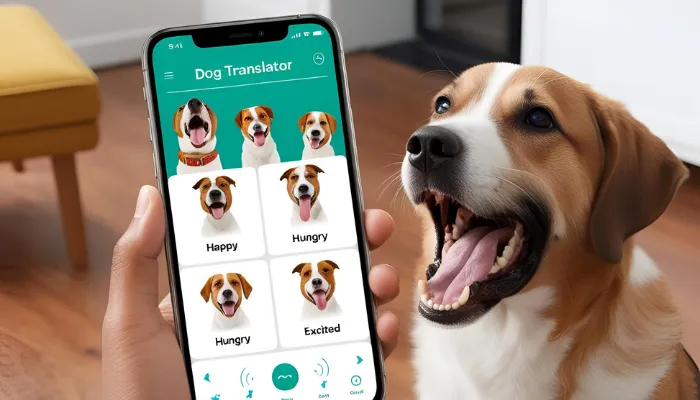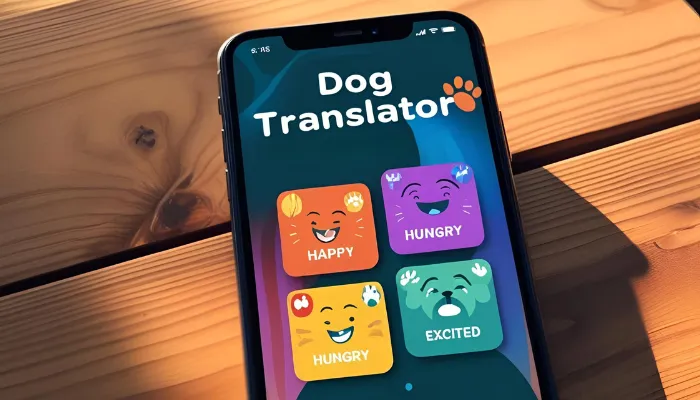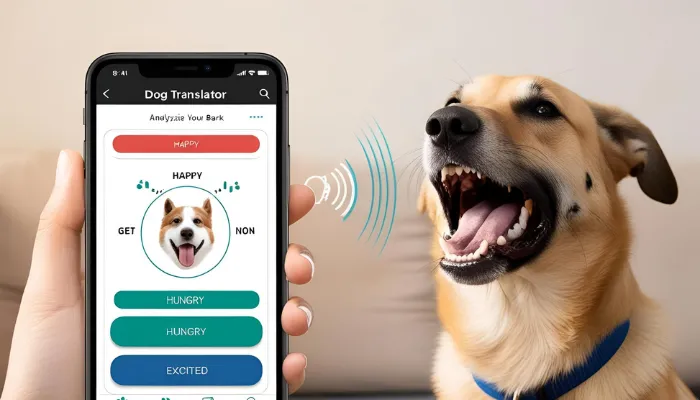The idea of a dog language translator has captured the imagination of pet owners everywhere. From apps that claim to decode barks to gadgets that analyze tail wags, these tools promise to bridge the communication gap between humans and dogs.
Some even offer a dog language translator online free version, making the tech accessible to anyone with a smartphone. But do they really work, or are they just a gimmick? Is there a dog translator that truly understands your furry friend? In this article, we’ll dig into the science, the hype, and whether these translators are worth your time (or treats). Let’s bark into it!

Dog Language Translator: What is it?
The concept of a dog language translator sounds like something straight out of a sci-fi movie. Imagine holding up a device to your pup and instantly knowing whether they’re saying, “I’m hungry” or “That squirrel is public enemy #1.” But how close are we to making this a reality?
How Do Dog Language Translators Work?
Most translators rely on a mix of audio analysis, body language tracking, and AI algorithms. Here’s a breakdown:
- Bark Decoding: Apps like Bowlingual or WoofWare record barks and compare them to a database of vocalizations linked to emotions (e.g., excitement, fear).
- Body Language Scanners: Tools like the Inupathy harness use heart rate sensors and LED colors to indicate your dog’s mood (red for stressed, blue for calm).
- AI-Powered Apps: Free online tools, such as an english to dog translator, might use machine learning to “guess” emotions based on tail position, ear movement, or facial expressions.
Types of Dog Language Translators:
| Type | How It Works | Example |
|---|---|---|
| Audio-Based | Analyzes pitch/frequency of barks | Bowlingual |
| Wearable Tech | Tracks heart rate and body temperature | Inupathy |
| AI Apps | Scans photos/videos for body language cues | Dog language translator online free tools |
While these tools offer exciting possibilities, their accuracy is still evolving, making human observation the best way to understand your dog.
Science Behind Dog Communication
The explanation of how dogs communicate is essential for developing accurate dog translator apps. Dogs express their feelings and intentions using sounds, body movements, and even smell. Here are some insights:
1. Making A Sound
It’s a known fact that dogs bark and growl in different ways to express different emotions. Scientists have classified the sounds dogs make into:
- Excitement or short high-pitched barks – Alarms or alert calls
- Aggression or defense – Deep growls of anger or lengthy grumpy rumbling
- Whipsers of whining or asking attention – Discomfort or slightly anxious
2. Movement and Conduct
A dog can communicate using a combination of their tails, body posture and even their facial expressions. For example:
- Friendly members of pack will show – Relaxed bodies and wagging tails
- Alert members of the pack – Raised body and stiff tails
- Surrendered while cowering – Partner of low ranking showing tamed and helpless behavior while tail tucked in
3. Communicating Using Smell
To differentiate themselves from Humans, dogs rely primarily on smell to identify their surroundings and other creatures, unlike people. Other dogs get important social and emotional information from pheromones released from glands.
4. Emotion and Brain Functioning
Recent research done with scans in MRI machines suggest that dogs have emotions similar to humans. Their brains react differently to positive and negative tones, which implies that they are able to physically respond to human emotions.
Understanding these scientific insights helps strengthen the bond between humans and their furry companions, making communication more natural and intuitive.

Do Dog Language Translators Actually Work?
Let’s cut to the chase: Can a how to speak dog language translator really decode your dog’s thoughts? The answer is… kinda.
The Pros:
- Fun Bonding Tool: Apps can make you more mindful of your dog’s behavior.
- Early Stress Detection: Wearables might flag health issues (e.g., abnormal heart rates).
- Accessibility: A dog language translator online free tool is low-commitment for curious owners.
The Cons:
- Over-Simplification: Dogs’ emotions are complex! A wagging tail doesn’t always mean joy.
- Tech Limitations: Background noise or poor lighting can skew app results.
- No Substitute for Intuition: You know your dog best—tech can’t replace that.
Pros vs. Cons of Dog Language Translators
| Pros | Cons |
|---|---|
| Encourages observation | Inaccurate interpretations |
| Detects health changes | Requires ideal conditions (quiet, good lighting) |
| Affordable/free options | Doesn’t replace human intuition |
While a dog language translator online free tool can be fun and insightful, nothing beats real-life experience, patience, and a deep bond with your dog.

Top 3 Dog Language Translators to Try
Want to try a dog bark translator? While no tool can fully “translate” dog language, these groundbreaking apps can help interpret your pup’s emotions:
1. Inupathy Harness ($199)
This exceptional harness analyzes your dog’s heart rate which allows one to know the mood of the dog. It shows emotions through color coded LED lights. This device is great for worrisome pups since it aids in stress level monitoring and gives real time context to their well-being.
2. Dog Decoder App (Free / $4.99 Premium)
It enables one to read the body language of a dog and analyze it from the provided pictures. This helps a pet parent to gauge their dog’s feelings based on the way the dog uses its body; its posture, facial expressions and tail movement. This is greatly beneficial for training and communication purposes.
3. BarkTranslator.com (Free)
This is an online application that allows the user to upload a bark for toy upload transcription and audio visualization. It is not scientifically verified but fun way to play with your animal and try to understand their vocal patterns.
These tools provide great analysis, but the ultimate way to find out what is on the mind of your dog is through their behavior and body language. However, these gadgets make parenting pets much more entertaining and playful!
How to Use a Dog Language Translator Effectively?
While dog language translators can be entertaining and informative, their correct usage determines how accurate and helpful they can be. Below is the best way to make the most out of these tools.
- Select The Right Translator:
- Some tools can analyze barks and others can tell the mood of the dog through body gestures or heartbeats. Choose one that suits your specific requirements.
- Use in a Controlled Environment:
- Low accuracy can result if there are excessive noises, bad lighting or any form of distraction. To achieve the best results, ensure for a quiet environment.
- Observe Body Language Alongside Translations:
- Communication devices are incapable of replacing natural contextual body language. Add tail position, ear movement and facial expression to the results for better understanding.
- Don’t Rely Solely on Technology:
- Although these tools are entertaining, they do not substitute your unique bond and the ability to understand your dog. use them as translational aids, not substitutes.
Improving your communication with your furry friend while maintaining interactions meaningful is possible when you combine technology with observation. It enables you to reach a comprehensible outcome.
Traditional Ways to Understand Your Dog
Even though technology provides interesting ways to decode canine communication, traditional methods remain the most accurate way to understand your furry friend. While a dog language translator can offer insights, observing body language, vocal cues, and daily interactions is the best way to truly connect with your dog.
- Body Language Interpretation
- Canines express themselves through their tails, ears, mouths, and even their facial muscles. Remember, a wagging tail does not mean happiness; it can also depend on how fast it is being wagged and its position where it is at. Once you learn these things, you can pick up on their emotions.
- Listen to Your Dog
- Fido has many methods of communicating, from barks and growls to whines and sighs. Each will have its own separate meaning. For instance, your dog might bark loudly as a form of excitement while whining can express sadness. These few sounds can help grow your bond with your dog.
- Commands and Training
- Using training aids like phrases and hand signs aid while giving commands in the form of a message. It increases clarity of what you intend to say to your dog. When it comes to Fido consistency, positive-reinforcement, and patience makes him friendly and helps build understanding towards him.
- Routine And Play
- Building a bond is effortless and even more aided when doing the things Fido enjoys like toys, walks, and hugging. While humans want everything to be in order, dogs enjoy routines along with familiarity something they need without using technology.
While dog language translator apps and gadgets are fun, the best way to understand your dog is through patience, observation, and consistent interaction. The more you tune into their natural behaviors, the better your communication will be!
Conclusion
The dream of a flawless dog language translator isn’t here yet—but we’re getting closer. While these tools can’t replace human intuition, they’re a fun way to engage with your pup’s world. Free options like a dog language translator online free app are worth a try, even if just for laughs.
At the end of the day, the best “translator” is still you: paying attention, learning their quirks, and sharing endless snuggles. After all, love is a language every dog understands.
